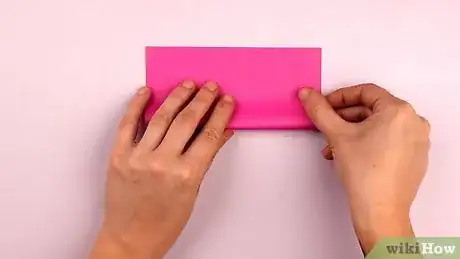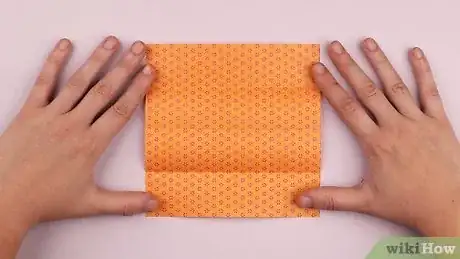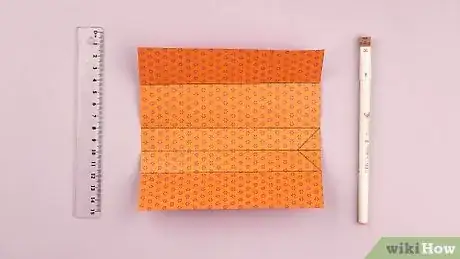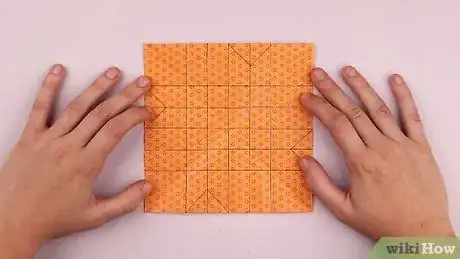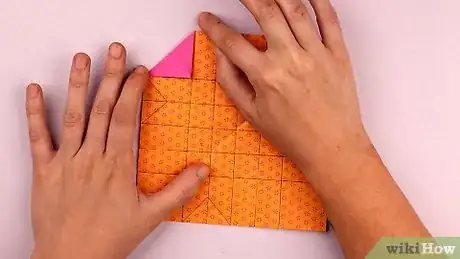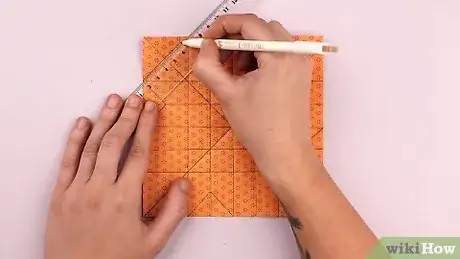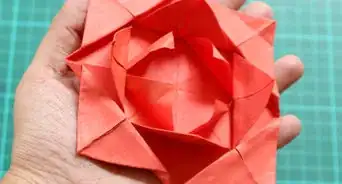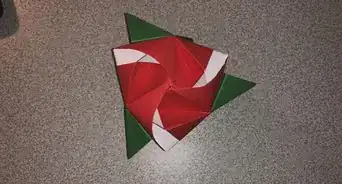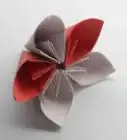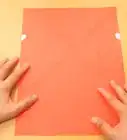wikiHow is a “wiki,” similar to Wikipedia, which means that many of our articles are co-written by multiple authors. To create this article, 163 people, some anonymous, worked to edit and improve it over time.
There are 29 references cited in this article, which can be found at the bottom of the page.
The wikiHow Video Team also followed the article's instructions and verified that they work.
This article has been viewed 3,537,790 times.
Learn more...
Folding a rose is an intermediate project that results in a beautiful, decorative flower. It all starts with a simple square that's carefully folded into a spiral pattern. The rose comes together as four petals tightly twisted around a square base. Once you make your first rose, you'll want to make several more so you can create an entire bouquet of these pretty paper flowers. Become an absolute expert. Take our wikiHow Origami Course!
Steps
Making the Base Folds
-
1Fold a square piece of paper in half (Start with the colored side down, white side up). Bring the bottom edge of the paper up to meet the top edge. Crease the fold with your fingers, working from the center outwards.
- Choose any color you'd like, so long as the two sides are different in color or texture.
- In the origami world, this is known as a "valley fold," because it creates a little valley in the paper Almost every origami project begins with a valley fold or its opposite, the mountain fold, which creates a ridge.[1]
- Orient the crease horizontally, with the red side down.
-
2Fold the bottom half in half. Line up the bottom edge of the paper to meet the horizontal crease in the middle. [2]
- Crease the new fold with your fingers.
Advertisement -
3Fold the top half in half. Bring the top edge of the paper to meet the lower horizontal crease.[3]
- Crease the new fold with your finger.
-
4Unfold the paper. Now there are three horizontal creases in the paper making four equal sections.[4]
-
5Fold the bottom in three-quarters. Make sure your paper is oriented so that the three creases you created in the previous step are horizontal, with the red side down. Take the bottom edge of the paper (The side closest to your body) and drag it up across the surface of the paper until it meets the crease that is closest to the top. The crease you are trying to get the bottom edge to meet with is located one fourth of the way down the paper from the top.[5]
- Crease the new fold with your fingers or a bone folder.
- If you've done the fold correctly, the area between the crease in the middle of the paper and the crease three-fourths of the way down the paper has been split in half with your new fold.
- You can unfold the crease you just made to make sure you did it right. However, make sure to fold it back into place before moving on to the next step.
-
6Fold the bottom-right corner in. Take hold of the bottom-right corner (as made by the bottom crease) and make a small diagonal fold at a 45 degree angle. The corner should fold upward so that a small portion of the right edge of the paper aligns with nearest crease.[6]
-
7Unfold the paper. You should see four horizontal creases. Of your four original areas, the one second from the bottom should be divided in half by one of these horizontal creases. Additionally, in this same area, you should see two small diagonal creases on the right side.[7]
- Of these two diagonal creases, one should be going up at a 45 degree angle from the horizontal crease, and the other down at the same angle.
-
8Mark the creases. Using a pen or pencil, draw lines along your creases.[8]
-
9Rotate the paper 180 degrees and repeat. Turn the paper so that the top becomes the bottom. Then, repeat steps 7 through 10.[9]
-
10Rotate the paper 90 degrees and repeat. Turn the paper one quarter of a turn, then repeat steps 2 through 10.[10]
-
11Rotate 180 degrees and repeat. Turn the paper another half-turn, then repeat steps 7 through 10.[11]
Making the Diagonal Folds
-
1Fold the paper in half diagonally. With the red side still down, take the lower right corner and bring it to meet the upper left corner. Crease the fold with your finger.[12]
-
2Unfold the paper. Open it up to reveal a new diagonal crease.[13]
-
3Fold the paper on the opposite diagonal. Rotate the paper 90 degrees and repeat the previous two steps.[14]
-
4Unfold the paper. Open it up to reveal two diagonal creases that form an "X" through the paper.[15]
-
5Fold the top-left corner. In each corner of your paper, you should now see a small square that is divided by a single diagonal crease. Take hold of the top left corner and fold it inward, creating a crease that is perpendicular to the original diagonal crease.[16]
- The corner of your paper should align with the bottom-right corner of the small square.
-
6Unfold and mark all the new creases formed. You should now see a small "X" in the top left corner. Draw a line along the new crease.[17]
-
7Fold the bottom-right corner up to the new line. Take the bottom-right corner and bring it up so that the point of the corner just touches the new line you drew in the previous step.[18]
- This should create a new crease that runs parallel to one of the lines making up the big "X," specifically the one running from bottom-left to top-right.
-
8Unfold and mark. Unfold and draw a line along the new diagonal crease.[19]
-
9Rotate and repeat. Turn the paper 180 degrees and repeat the previous four steps.[20]
- You should now see three lines running parallel from the bottom-left corner of your paper up to the top right.
-
10Rotate and repeat, again. Now turn the paper 90 degrees and repeat steps 5 through 9 (of Part 2).[21]
- When you are done, you should have three parallel lines running from bottom-left to top-right and three running from top-left to bottom-right.
Creating the Structure
-
1Fold in the four corners. As in step 5 of Part two, fold in all four corners. You should not need to make any new creases to do this.[22]
- The end result will be an octagon.
-
2Turn the paper over. The red side of your paper should now be face up.[23]
-
3Locate the small triangle. Along the bottom edge of your paper, you should see a small creased triangle. It has a crease down the middle, making it look like two smaller triangles that share a vertical side.
- If you have trouble finding it, look for the triangle's right-most corner. The triangle's right-most corner is in the spot where the bottom edge of the paper, which is horizontal, meets the bottom-right edge of the paper, which is diagonal.
- If the small triangle isn't there, check to make sure you did step eight of part one correctly.
-
4Make an inside reverse-fold in the bottom. If you don't know what an inside reverse-fold is or forget how to do an inside reverse-fold, follow the steps below[24]
- Fold the center crease of the triangle you located in the last step gently inward, creating a small valley fold.
- At the same time, fold the two diagonal sides of the triangle outward to create small mountain folds.
- This should result in the small triangle creating a small "notch" on the side of the paper.
- Then, create one more mountain fold along the crease extending from the tip of the triangle.
- This is called an inside reverse-fold.[25]
-
5Make another inside reverse-fold. In what was once the bottom left corner, you'll need to fold another notch of a slightly different shape.[26]
- Directly to the right of the small triangle (The one you just made an inside reverse fold with) is another crease. It runs parallel to the right side of the smaller triangle and is perpendicular to the side of the octagon.
- Push gently inward along this crease to create a valley fold.
- Then, as before, push the sides of the triangle gently outward, creating small ridges.
- Finally, create one more valley fold, pushing inward the nearest horizontal crease that runs parallel to the horizontal side of your new "notch."[27]
- This last crease should run out to just past the center of your paper, creating one side of the small square in the center that you can see marked out on the reverse side.
-
6
Creating the Petals
-
1Use the valley fold on each petal's edge. Now that the basic structure of your rose is in place, it's time to start working on the petals. As your first step, you'll need to add a valley fold the outside edge of each one.[30]
- You'll see that, if you look a your rose from above, it has four long valleys extending out from a square in the center. On the right side of each of these is a large, flat surface. Grasp the edge of this surface and fold it inward.
- Specifically, grab the three sides of the outside edge and fold them in such that a small tab shaped like a trapezoid is formed.[31]
-
2Fold in the corners. Looking at your rose from the side, you should now see that you have four shapes that look like triangles with one corner chopped off (along the area you just valley-folded). Protruding from the base of each of these you should see a small triangle of the white side of your paper. Fold in the right-side point of each of these "chopped-off" triangles.[32]
- Draw an imaginary line straight up from the bottom point of the "white" triangle, and make a valley fold along it.[33]
-
3Unfold the corners and reverse fold them. Unfold the valley folds you just made to the tips. Then, reverse fold them such that each tip disappears inside the rose.[34]
- If you've done this correctly, the white triangles should no longer be visible.
-
4Add tiny valley folds. Your "chopped off" triangles should now look like they have two points chopped off: one on the left and a tiny one on the right, created by your reverse folds. You'll now fold up the tiny "chopped" side at a 45 degree angle from the base of the "chopped" triangle (i.e. the edge of the paper).[35]
-
5Unfold and reverse fold. Unfold the valley folds you just made, and then reverse fold along the same lines, folding the tiny triangle you created in the previous step inside the rose at all four points.[36]
-
6Fold down the edges. Your "chopped off" triangle should now have reverse folds at each "chopped" edge. These will allow you to make a small valley fold, horizontal to the base of each triangle, folding the resulting tab outward. Do this to all four petals.[37]
-
7Create legs. Bring the petals together to create "legs." For each set of petals, pull them close together such that the right-side one sits just behind the left-side one. Press down on the creases to hold them in place. The result should be four pointed and fairly sturdy legs.[38]
- If you've done this right, you should be able to see little or no white-side surface on the legs when looking at your rose from the side.
-
8
-
9Turn the rose over. The square that you are looking down on will become the top of the rose.[41]
-
10Push in the quadrants. The square on top of your rose should be divided into four quadrants by creases. With your finger, gently push in each quadrant, leaving in place the ridges that form an "X" over the top of the square.[42]
-
11Rotate. Place a finger into each of the four quadrants around the "X" and gently rotate.[43]
- This should give the top of rose a more swirled, organic feel, as opposed to the hard lines of the "X."
-
12Make a swirl. With a pair of tweezers, grab the center of what was once the "X," and slowly but firmly continue to rotate, being careful not to tear the paper.[44]
- As you do this, the center of the rose will sink inside, creating a more realistic look.
- This may take several tries to get right.
-
13Curl the petals. Using two fingers, take each petal by the point and roll it toward the center, then release. This will create nicely curled petals.[45]
Adding a Stem (Optional)
-
1Get a new piece of paper. If you want to add an origami stem, start with a fresh piece of paper, preferable green.
-
2Start with the white side up and fold it in half. Valley fold the paper, from corner to corner, creating two triangles, then unfold.[46]
-
3Fold the corners in. Create two more valley folds, folding the left and right corners in toward the center crease, creating a kite shape.[47]
-
4Repeat. Fold the corners in again toward the center crease. Then do it one more time. You should now have a very skinny kite shape.[48]
-
5Turn it over and fold upward. Flip your stem over so that the edges of the paper all face hidden, then fold the bottom point up to the top one.[49]
-
6Fold it in half. Now, fold the stem in half along the vertical axis.[50]
-
7Fold down the sides, then reverse fold. Fold the outer part (which will become the leaf) of the paper outward, away from the inside (stem), creating two diagonal creases. Then, reverse fold the leaf out and away from the stem. It will have crease in the center.[51]
-
8Attach the stem. Put the pointed end of the stem through the small hole in the underside of your rose where the "legs" all meet.
Community Q&A
-
QuestionWhat is the meaning of the color of the roses?
 Community AnswerRed = Love and romance. Dark pink = Used when thanking someone. Pink = Happiness. Light Pink = Color of rose given to someone to show sympathy. White = Innocence and purity. Lavender = Someone has 'cast you under their spell' (or falling in love, in other words). Orange = Desire. Blue = Rarity. A mixture of red and white = Unity.
Community AnswerRed = Love and romance. Dark pink = Used when thanking someone. Pink = Happiness. Light Pink = Color of rose given to someone to show sympathy. White = Innocence and purity. Lavender = Someone has 'cast you under their spell' (or falling in love, in other words). Orange = Desire. Blue = Rarity. A mixture of red and white = Unity. -
QuestionDo we have to make a stem?
 Community AnswerPart 5 of this guide explicitly states that making a stem for your rose is optional.
Community AnswerPart 5 of this guide explicitly states that making a stem for your rose is optional. -
QuestionWhat kind of paper should I use?
 Community AnswerAny paper is fine, but construction and manila paper are not recommended as they are difficult to be exact when folding.
Community AnswerAny paper is fine, but construction and manila paper are not recommended as they are difficult to be exact when folding.
References
- ↑ http://www.origami-instructions.com/origami-valley-and-mountain-folds.html
- ↑ http://www.origami-flower.org/origami-rose-swirl/page-03.php
- ↑ http://www.origami-flower.org/origami-rose-swirl/page-03.php
- ↑ http://www.origami-flower.org/origami-rose-swirl/page-04.php
- ↑ http://www.origami-flower.org/origami-rose-swirl/page-04.php
- ↑ http://www.origami-flower.org/origami-rose-swirl/page-05.php
- ↑ http://www.origami-flower.org/origami-rose-swirl/page-05.php
- ↑ http://www.origami-flower.org/origami-rose-swirl/page-05.php
- ↑ http://www.origami-flower.org/origami-rose-swirl/page-06.php
- ↑ http://www.origami-flower.org/origami-rose-swirl/page-06.php
- ↑ http://www.origami-flower.org/origami-rose-swirl/page-06.php
- ↑ http://www.origami-flower.org/origami-rose-swirl/page-07.php
- ↑ http://www.origami-flower.org/origami-rose-swirl/page-07.php
- ↑ http://www.origami-flower.org/origami-rose-swirl/page-08.php
- ↑ http://www.origami-flower.org/origami-rose-swirl/page-08.php
- ↑ http://www.origami-flower.org/origami-rose-swirl/page-08.php
- ↑ http://www.origami-flower.org/origami-rose-swirl/page-09.php
- ↑ http://www.origami-flower.org/origami-rose-swirl/page-09.php
- ↑ http://www.origami-flower.org/origami-rose-swirl/page-10.php
- ↑ http://www.origami-flower.org/origami-rose-swirl/page-10.php
- ↑ http://www.origami-flower.org/origami-rose-swirl/page-11.php
- ↑ http://www.origami-flower.org/origami-rose-swirl/page-11.php
- ↑ http://www.origami-flower.org/origami-rose-swirl/page-12.php
- ↑ http://www.origami-flower.org/origami-rose-swirl/page-13.php
- ↑ http://www.origami-flower.org/origami-rose-swirl/page-13.php
- ↑ http://www.origami-flower.org/origami-rose-swirl/page-14.php
- ↑ http://www.origami-flower.org/origami-rose-swirl/page-14.php
- ↑ http://www.origami-flower.org/origami-rose-swirl/page-20.php
- ↑ http://www.origami-flower.org/origami-rose-swirl/page-21.php
- ↑ http://www.origami-flower.org/origami-rose-swirl/page-22.php
- ↑ http://www.origami-flower.org/origami-rose-swirl/page-23.php
- ↑ http://www.origami-flower.org/origami-rose-swirl/page-23.php
- ↑ http://www.origami-flower.org/origami-rose-swirl/page-24.php
- ↑ http://www.origami-flower.org/origami-rose-swirl/page-25.php
- ↑ http://www.origami-flower.org/origami-rose-swirl/page-25.php
- ↑ http://www.origami-flower.org/origami-rose-swirl/page-26.php
- ↑ http://www.origami-flower.org/origami-rose-swirl/page-27.php
- ↑ http://www.origami-flower.org/origami-rose-swirl/page-28.php
- ↑ http://www.origami-flower.org/origami-rose-swirl/page-29.php
- ↑ http://www.origami-flower.org/origami-rose-swirl/page-31.php
- ↑ http://www.origami-flower.org/origami-rose-swirl/page-32.php
- ↑ http://www.origami-flower.org/origami-rose-swirl/page-32.php
- ↑ http://www.origami-flower.org/origami-rose-swirl/page-33.php
- ↑ http://www.origami-flower.org/origami-rose-swirl/page-35.php
- ↑ http://www.origami-flower.org/origami-rose-swirl/page-36.php
- ↑ http://www.origami-fun.com/origami-flower-stem.html
- ↑ http://www.origami-fun.com/origami-flower-stem.html
- ↑ http://www.origami-fun.com/origami-flower-stem.html
- ↑ http://www.origami-fun.com/origami-flower-stem.html
- ↑ http://www.origami-fun.com/origami-flower-stem.html
- ↑ http://www.origami-fun.com/origami-flower-stem.html
About This Article
To fold a paper rose, use a square piece of paper and make the base folds, then unfold each base fold to create creases. Next, use a straight edge and pencil to mark each crease you made. Then, make the diagonal folds, unfold them, and mark those creases. Use your marked guidelines to fold the paper until you have the basic structure, then move on to the intricate final folds to create the rose petals! To learn about the specific folds you need to make, read on!
